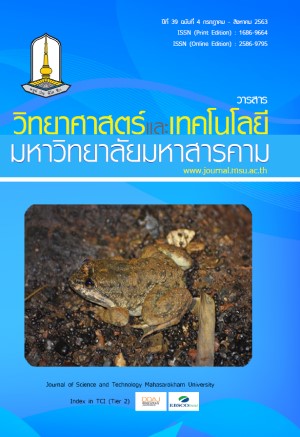Estimation of Suspended Sediment Concentration Along the Pao River using Sentinel-2 Imagery
Main Article Content
Abstract
Monitoring and quantifying suspended sediment concentration (SSC) along the rivers provide important information for reservoir management. Traditional monitoring based on in situ measurements of SSC through in-situ sampling in rivers is expensive and time-consuming to perform. The objective of this study was to use spectral information provided by remote sensing from Sentinel-2 images in combination with machine learning to estimate SSC in the pao river. Three machine-learning regression algorithms (multiple linear regression, deep learning, and Support Vector Machine : SVM) were evaluated and a suitable model created to estimate SSC of the pao river. The results show that the Support Vector Machine model gave the most balanced results, with the lowest RMSE values and a high statistical correlation (R2=0.863 ; RMSE = 11.9) for the whole range of SSC (0 to 90 mg/l) measured at this station during the studied period. The methodology presented in this study can be used as a guideline for the combination of machine learning with Sentinel-2 images for estimating
Article Details
References
2. C.Montanher, O. (2014). Empirical models for estimating the suspended sediment concentration in Amazonian white water rivers using Landsat 5/TM. 67-77.
3. Chen, I. J., & Paulraj, A. (2004). Towards a theory of supply chain management: the constructs and measurements. Journal of operations management, 22(2), 119-150.
4. Gao, J. and S. O'leary, Estimation of suspended solids from aerial photographs in a GIS. International Journal of Remote Sensing, 1997. 18(10): p. 2073-2086.
5. Syvitski, J.P., et al., Estimating fluvial sediment transport: the rating parameters. Water resources research, 2000. 36(9): p. 2747-2760.
6. Jensen, R. and M. Binford, Measurement and comparison of Leaf Area Index estimators derived from satellite remote sensing techniques. International Journal of Remote Sensing, 2004. 25(20): p. 4251-4265.
7. Jongschaap, R.E., Run-time calibration of simulation models by integrating remote sensing estimates of leaf area index and canopy nitrogen. European Journal of Agronomy, 2006. 24(4): p. 316-324.
8. Fang, S., et al., Methods to break seed dormancy in Cyclocarya paliurus (Batal) Iljinskaja. Scientia Horticulturae, 2006. 110(3): p. 305-309.
9. Ritchie, J.C. and C.M. Cooper, Comparison of measured suspended sediment concentrations with suspended sediment concentrations estimated from Landsat MSS data.
TitleREMOTE SENSING, 1988. 9(3): p. 379-387.
10.ANJI REDDY, M. and S. Srinivasulu, Comparison of IRS-IB LISS-IIA pixel array sizes for estimating suspended solids concentration in Hussain Sagar Lake, Hyderabad, India—a statistical approach. International Journal of Remote Sensing, 1994. 15(18): p. 3693-3706.
11. Doxaran, D., et al., Spectral signature of highly
turbid waters: Application with SPOT data to quantify suspended particulate matter concentrations. Remote sensing of Environment, 2002. 81(1): p. 149-161.
12. Wang, Z., et al., Image quality assessment: from error visibility to structural similarity. IEEE transactions on image processing, 2004. 13(4): p. 600-612.
13. Miller, R.L. and B.A. McKee, Using MODIS Terra 250 m imagery to map concentrations of total suspended matter in coastal waters. Remote sensing of Environment, 2004. 93(1-2): p. 259-266.
14. Ma, R. and J. Dai, Investigation of chlorophyll‐a and total suspended matter concentrations using Landsat ETM and field spectral measurement in Taihu Lake, China. International Journal of Remote Sensing, 2005. 26(13): p. 2779-2795.
15. Islam, M.R., Y. Yamaguchi, and K. Ogawa, Suspended sediment in the Ganges and Brahmaputra Rivers in Bangladesh: observation from TM and AVHRR data. Hydrological Processes, 2001. 15(3): p. 493-509.
16. Onderka, M. and P. Pekárová, Retrieval of suspended particulate matter concentrations in the Danube River from Landsat ETM data. Science of the total environment, 2008. 397(1-3): p. 238-243.
17. Wang, C., Variability of the Caribbean low-level jet and its relations to climate. Climate dynamics, 2007. 29(4): p. 411-422.
18. Wang, L., et al., DEGseq: an R package for identifying differentially expressed genes from RNA-seq data. Bioinformatics, 2009. 26(1): p. 136-138.
19. Fang, S., Wang, J., Wei, Z., & Zhu, Z. (2006). Methods to break seed dormancy in Cyclocarya paliurus (Batal) Iljinskaja. Scientia Horticulturae, 110(3), 305-309
20. Peterson, K., Sagan, V., Sidike, P., Cox, A., & Martinez, M. (2018). Suspended Sediment Concentration Estimation from Landsat Imagery along the Lower Missouri and Middle Mississippi Rivers Using an Extreme Learning Machine. Remote Sensing, 10(10), 1503.
21. Lima, T.A., Beuchle, R., Langner, A., Grecchi, R.C., Griess, V.C. and Achard, F., 2019. Comparing Sentinel-2 MSI and Landsat 8 OLI Imagery for Monitoring Selective Logging in the Brazilian Amazon. Remote Sensing, 11(8), p.961.
22. Mandanici, E. and Bitelli, G., 2016. Preliminary comparison of sentinel-2 and landsat 8 imagery for a combined use. Remote Sensing, 8(12), p.1014.
23. Pham, Q., Ha, N., Pahlevan, N., Oanh, L., Nguyen, T., & Nguyen, N. (2018). Using Landsat-8 Images for Quantifying Suspended Sediment Concentration in Red River (Northern Vietnam). Remote Sensing, 10(11), 1841.
24. Wang, J. J., & Lu, X. X. (2010). Estimation of suspended sediment concentrations using Terra MODIS: An example from the Lower Yangtze River, China. Science of the Total Environment, 408(5), 1131-1138.
23. Larson, M. D., Simic Milas, A., Vincent, R. K., & Evans, J. E. (2018). Multi-depth suspended sediment estimation using high-resolution


